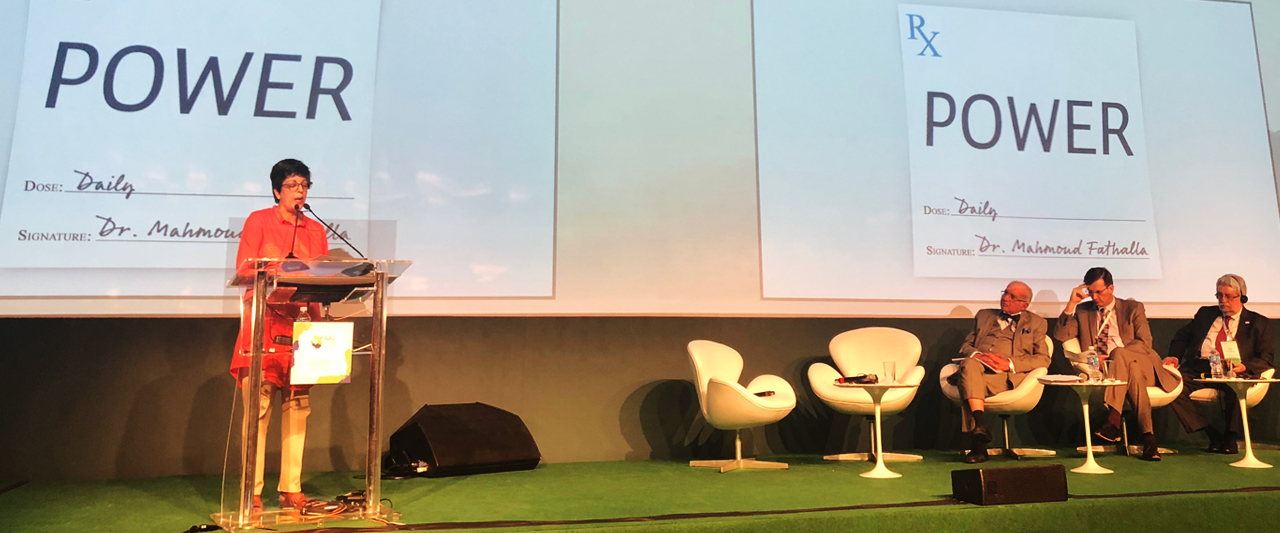Adapted from Kumar’s Mahmoud Fathalla Lecture, “The centrality of reproductive health and choice in women’s lives,” presented at the 2018 FIGO World Congress of Gynecology and Obstetrics. Dr. Fathalla, a former president of the International Federation of Gynecology and Obstetrics (FIGO), is a lifelong women’s health and rights champion.
Women and girls everywhere must have the power to safely make their own reproductive health decisions. After all, women’s rights are human rights, and human rights are about power. But around the world, and especially in the global South, we continue to see that women and girls lack this power—and there are severe consequences.
One central fact is that women in developing countries spend much more of their lives being pregnant than women in developed countries. In Afghanistan, for example, the fertility rate is 4.8 children per woman. This means the average Afghan woman spends nearly three and a half years of her life in pregnancy. Across the developing world each year, 16 million women and girls aged 15-19 give birth. Complications during pregnancy and childbirth are the leading cause of death for these women and girls, and every year nearly four million of them have unsafe abortions.
These facts have a profound impact on the life paths available to women and girls, and that impact is very different depending on where they live. While thousands of women and girls die and millions more are injured each year because of unsafe abortion, we know that the vast majority are in developing countries. So what can we do? How do we ensure that women and girls everywhere have the power to determine their own futures? First, we need to think about reproductive health care in a larger context.
Two very different paths
Let’s consider a girl named “Mila” in the Netherlands, where the fertility rate is quite low at 1.6 children per woman. There is a high likelihood that Mila will finish high school and go on to university. Nearly half of Dutch women aged 25-45 have at least a bachelor’s degree. During her primary and secondary school years, Mila will receive comprehensive sexuality education. If she wants it, free contraception is available to Mila. Contraceptive use is high in the Netherlands, with nearly 75% of married women aged 15-49 using it. If Mila needs to have an abortion, she can get a safe and legal one. If she chooses to have children, Mila will get high-quality maternal health care and there is a comprehensive child-care system to assist her. Because Mila has had the opportunity to get an education and go to college, she can enter the workforce. As she ages, Mila can earn a good living and contribute to her community and country. Her life expectancy is 83 years.
Now let’s consider the path of a girl named “Luzolo” who lives in the Democratic Republic of the Congo (DRC), in sub-Saharan Africa, where the fertility rate is 6.3 children per woman. Unlike Mila, Luzolo may have grown up in a conflict zone. She is not likely to get a high school education. In low-income countries like the DRC, only one in three girls completes lower-secondary education. Luzolo is also not likely to have access to contraception. In the DRC, only 8% of married women aged 15-49 are using modern contraceptive methods. If Luzolo has an unwanted pregnancy and needs an abortion, she may have to resort to an unsafe abortion and put her life at risk. Until just a few months ago, abortion was legally restricted in the DRC.
Luzolo probably will have her first child as a teenager and will not get maternal health care. Then she is likely to have four more children—and with each pregnancy, she will risk her life. If she does manage to get employment, her earnings will be minimal. As she ages, Luzolo’s lack of education and job opportunities—combined with multiple pregnancies—will mean a life of poverty. Because of all those pregnancies and the possibility that she might seek out an unsafe abortion, her risk of death is higher. In fact, the maternal mortality rate in the DRC is 693 deaths for each 100,000 live births. (That’s astonishingly high compared to the Netherlands’ very low rate of seven maternal deaths per 100,000 live births!) Luzolo’s life expectancy is just 61 years.
No power to choose her own path
Why is Luzolo’s path so much more difficult than Mila’s? Obviously, there are many large, powerful forces at work against Luzolo—and so many millions of young women like her. Women and girls in poor countries are pregnant too often, they don’t have access to birth control, they can’t access good health care, they don’t have enough education and they’re poor.
But let’s dig deeper. Why are they uneducated? Why don’t they have birth control? Why are they poor? The answers are, of course, complicated, and have to do with history, politics, racism, patriarchy, discrimination, cultural beliefs, stigma and, perhaps most importantly, power.
There’s no doubt we have made progress in terms of women’s rights. But we must acknowledge that even today, in the 21st century, many women still have little decisionmaking power over their lives—including over whether and when they want to be pregnant.
This lack of power harms them in myriad ways. At the interpersonal level, women and girls contend with family expectations about who they are allowed to marry and what the appropriate role is for a woman. At the community level, social norms can encourage women to give birth shortly after marriage or continue to have children until a boy is born. In many cultures, women still do not get to make the fundamental decisions for themselves about whether to use contraception or get an abortion. Even in countries where contraception and safe abortion are legal, women may still have to ask permission from their husbands, parents or even their doctors. And at the broad societal level, no matter their age, their economic standing or where they live, women and girls must contend daily with sexual harassment, abuse, rape and other forms of gender-based violence.
Our power as advocates
As advocates for reproductive health and rights, as health-care providers and as members of the global community, our task is daunting—but we are ready. We need to tackle the challenges that face girls like Luzolo at every level of society.
One pressing need: We must end laws that make abortion a crime. Right now, nearly 25% of the world’s population lives in countries where abortion is prohibited entirely or is permitted only to save a woman’s life. The stated goal of these laws is to stop women from having abortions, yet abortion rates are actually higher in countries where abortion is banned or legally restricted. But these laws do stop many women from having the power to safely make their own choices about their bodies and lives, in turn making it far more likely that women will resort to unsafe abortion.
We also must confront the fierce, global anti-abortion movement. This movement claims that human rights are not universal, that reproductive rights are a Western construct, and that abortion and contraception destroy families and will end civilization. Tell that to a woman in the DRC who is dying from hemorrhage due to a sharp stick in her cervix and uterus because she wanted to end a pregnancy. Let there be no mistake, the anti-abortion movement wants to control women, silence women, and render women invisible. We cannot allow this to happen. We must be vigilant and aware of the links between movements that oppose abortion rights, immigration, LGBTQ rights, and the rights of minorities. These opposition movements undermine the universality and indivisibility of human rights and are fundamentally undemocratic.
Yet another pressing need: We must fight to dismantle abortion stigma, whose impact extends far beyond women. It marginalizes abortion care, facilities and providers. It shames and silences women, and it is a major contributor to unsafe abortion. For anti-abortion activists, abortion stigma is a prime weapon in their arsenal. They want to stigmatize abortion by passing laws that restrict it, by telling providers what to do and say about abortion, and by making women who have abortions feel ashamed. They don’t want abortion to be seen as a normal part of women’s health care.
Clearly, there is much to do. So when we think of Mila and Luzolo, the support they need and the barriers they face, my hope is that all of us ask ourselves each day: What can we do to create paths for women and girls that are filled with possibilities and hope?
As we get to work, let’s keep our focus on the millions of women and girls around the world like Luzolo, who have such a hard path to realizing their human rights and controlling their reproductive lives. We must stand up for them—and most of all, we must remember what the unwavering women’s rights advocate Dr. Mahmoud Fathalla said was the ultimate prescription for women: POWER.
For more information, contact [email protected]


